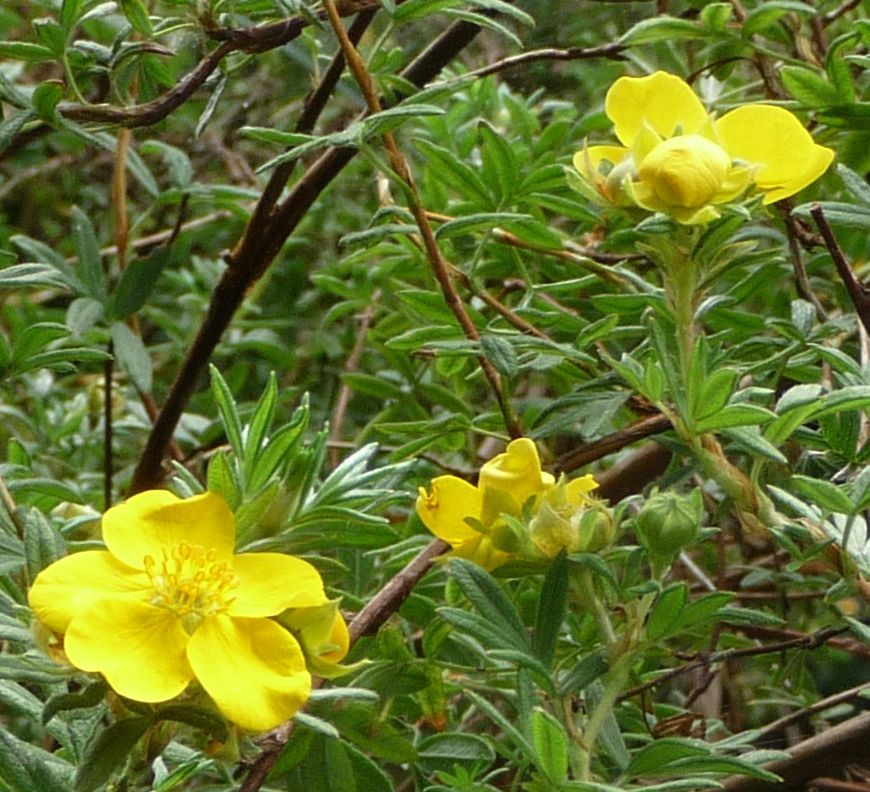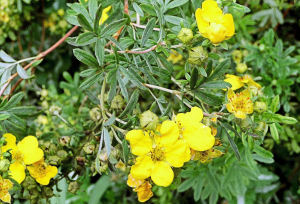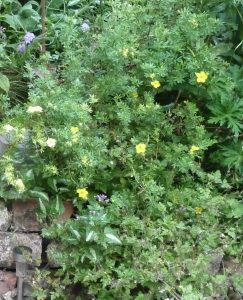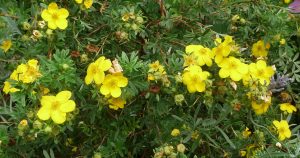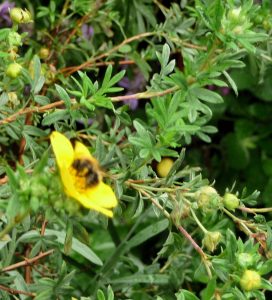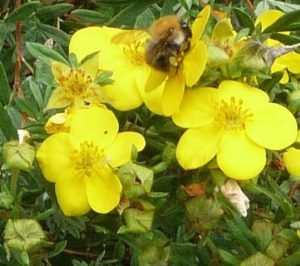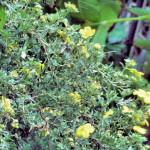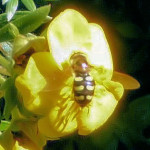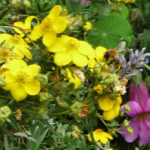POTENTILLA FRUTICOSA (Shrubby Cinquefoil)
Northern hemisphere
Potentilla fruticosa is a small shrub, a deciduous perennial. It prefers full sun or light shade and demands no special treatment. It performs best growing in moist soil, but will tolerate clay soils or those that are rocky, salt, dry or poor.
In late spring small sprays of mid-green leaves open on dry, twiggy branches. Buds that look like tidy individually-wrapped parcels appear at the tips of the sprays in May, opening into bright saucer-shaped BUTTER YELLOW flowers. They bloom until November.
2-4 ft tall by 3-5 ft wide
World Distribution
“POTENTILLA FRUTICOSA, A COMMON BUT LITTLE KNOWN PLANT
The bush cinquefoil (Potentilla fruticosa) is one of the few woody plants native over both northern hemispheres. It can be found as a low mat of dense woody growth on top of the Olympic Mountains in Washington or high up in the Himalayas, and as three-foot shrubs in Michigan, as well as in Great Britain, Europe and China.”
Arnoldia, a continuation of the Bulletin of Popular Information of the Arnold Arboretum, Harvard University, September 1955
“Ecology: In England, this shrub is found on basic, damp rock ledges and silty, sandy or gravelly river-flats liable to inundation. In Ireland, it occurs in rocky places subject to flooding, usually around loughs and turloughs. It also occurs as a garden escape or relic in waste places.” Potentilla Fruticosa/Online Atlas of the British and Irish Flora, https://plantatlas.brc.ac.uk › plant › potentilla-fruticosa
Medicinal, Traditional
The Shrubby Cinquefoil has antioxidant, anti-inflammatory, and anti-microbial properties.
https://abchealthonline.com/6591132-cinquefoil-useful-properties-root-use-indications
‘The leaves are astringent. The juice of the root is used in the treatment of indigestion. A tea is made from the dried leaves. Used as a substitute for China tea, especially by people living at high elevations in the Himalayas.’ Medicinal herbs, Shrubby Cinquefoil, Potentilla fruticosa, Mozilla Firefox.
“Shrub cinquefoil grows mainly in mountainous areas on moist, drained soils. It is widely used in Mongolian and Indo-Tibetan medicine as a decoction for gastrointestinal diseases. Due to the large number of biologically active compounds, cinquefoil is used as an anti-inflammatory, hemostatic and soothing agent.”
Cinquefoil – Useful properties, Root Use, Indications / Medicines 2022 — Mozilla Firefox
Low Maintenance
Potentilla is a robust plant that will withstand the elements. It grows in the UK & Ireland in damp rocky places subject to flooding. It is planted as hedging, along roadway verges, in exposed gardens, around supermarket carparks & beachfront properties. All it asks is full sun & good drainage,
Gardening Know How: Potentilla Plant Care: Tips For Growing Potentilla Shrub http://www.gardeningknowhow.com/ornamental/shrubs/potentilla/growing-potentilla-shrubs.htm
Bees’ Favourite.
The Potentilla blooms until mid-autumn and flowers are visited by a succession of Bees & other pollinators. This is a reliable Bees’ Favourite.
Other names: Anserina, Anserine, Argentina Anserine, Argentine, Bec d’ Oie, Crampweed, Creeping Cinquefoil, Creeping Tormentil, European Cinquefoil, Five Fingers, Goose Grass, Goose Tansy, Herbe aux Oies, Moor Grass, Potentilla Anserina, Potentille, Potentille Anserine, Potentille des Oies, Prince’s Feathers, Richette, Silverweed, Trailing Tansy, Wild Agrimony, Wild Tansy.
2013: Very few bees this year for the Potentilla. The long cold winter and wet spring have taken their toll.
2015: The Potentilla is having a good season. Many blooms, many pollinators, as witness the Hoverfly below.
2016: Another good year for the Potentilla. Winter and Spring may have been hard on some of its neighbours, but its many flowers had plenty of visitors.
